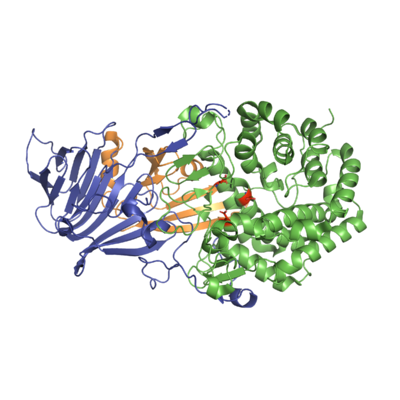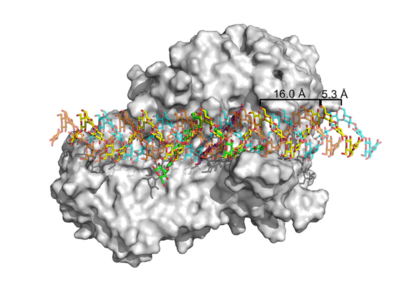CAZypedia needs your help! We have many unassigned GH, PL, CE, AA, GT, and CBM pages in need of Authors and Responsible Curators.
Scientists at all career stages, including students, are welcome to contribute to CAZypedia. Read more here, and in the 10th anniversary article in Glycobiology.
New to the CAZy classification? Read this first.
*
Consider attending the 15th Carbohydrate Bioengineering Meeting in Ghent, 5-8 May 2024.
Difference between revisions of "Glycoside Hydrolase Family 81"
| Line 50: | Line 50: | ||
== Family Firsts == | == Family Firsts == | ||
;First stereochemistry determination: β-glucan binding protein (GBP) from soybean (''Glycine max L.'') by <sup>1</sup>H-NMR <cite>Fliegmann2005</cite>. | ;First stereochemistry determination: β-glucan binding protein (GBP) from soybean (''Glycine max L.'') by <sup>1</sup>H-NMR <cite>Fliegmann2005</cite>. | ||
| − | ;First catalytic nucleophile identification: Lam81A from ''Thermobifida fusca'', by site-directed mutagenesis and azide rescue <cite>McGrath2009</cite>. | + | ;First catalytic nucleophile identification: Lam81A from ''Thermobifida fusca'', by site-directed mutagenesis and azide rescue <cite>McGrath2009</cite>, later confirmed by structural analysis <cite>Pluvinage2017</cite>. |
| − | ;First general acid/base residue identification: Lam81A from ''Thermobifida fusca'', by site-directed mutagenesis | + | ;First general acid/base residue identification: Lam81A from ''Thermobifida fusca'', by site-directed mutagenesis <cite>McGrath2009</cite>, later confirmed by structural analysis <cite>Pluvinage2017</cite>. |
;First 3-D structure: Lam81A from ''Rhizomucor miehei'' CAU432 <cite>Zhou2013</cite>. | ;First 3-D structure: Lam81A from ''Rhizomucor miehei'' CAU432 <cite>Zhou2013</cite>. | ||
Revision as of 10:04, 22 July 2020
This page is currently under construction. This means that the Responsible Curator has deemed that the page's content is not quite up to CAZypedia's standards for full public consumption. All information should be considered to be under revision and may be subject to major changes.
- Author: ^^^Julie Grondin^^^
- Responsible Curator: ^^^Al Boraston^^^
| Glycoside Hydrolase Family GH81 | |
| Clan | none |
| Mechanism | inverting |
| Active site residues | known |
| CAZy DB link | |
| http://www.cazy.org/GH81.html | |
Substrate specificities
GH81 family are endo-β(1,3)-glucanases (EC 3.2.1.39) with diverse physiological roles, such as plant biomass degradation, cell cycling, and enzymatic pathogen defense. They are mostly found in bacteria and fungi, and are particularly abundant in Saccharomyces and Streptomyces species. Activity has been demonstrated on laminarin [1, 2, 3, 4, 5, 6], curdlan [1, 3, 5, 6], and pachyman [2, 5].
Kinetics and Mechanism
GH81 enzymes follow an inverting mechanism, first shown by 1H-NMR during the hydrolysis of laminarin oligosaccharides [7], and laminarin [2], thus operating by a single-displacement mechanism.
Catalytic Residues
Primary sequence alignments of GH81 reveal a number of highly conserved residues, including two glutamate residues and one aspartate residue which are located in the active site cleft and likely to serve as catalytic residues [3, 4, 8].
Comprehensive mutagenesis experiments, azide rescue, structural analysis, and examination of the product conformational itinerary in ligand complexes show that one of the two glutamic acids (E542 in GH81 from Bacillus halodurans C-125) acts as the catalytic base by activating a catalytic water, and that the aspartic acid (D422 in BhGH81) acts as the catalytic acid [5, 8]. Mutagenesis studies in T. fusca indicate that mutation of the second glutamic acid (E546 in BhGH81) results in a dramatic reduction in activity [8]. Structural analysis in B. halodurans indicates that this residue is positioned during the catalytic cycle to interact with and stabilize a distorted product intermediate. As such, the potential role of this residue as a base and in activating the catalytic water prior to substrate binding is presently unclear.
Three-dimensional structures

GH81 are multimodular, although the composition of the domains can vary slightly. The first characterized structure, Lam81A from Rhizomucor miehei CAU432, comprises an N-terminal β-sandwich domain (domain A), a small α/β domain (domain B), and a C-terminal (α/α)6 domain (domain C) [4]. Domains A and C form the core of the enzyme, which is likely stabilized by domain B. (Figure 1). This architecture is largely conserved in the GH81 from Bacillus halodurans C-125 (BhGH81) [5], and the cellulosomal GH81 from Clostridium themocellum ATCC 27405 (CtLam81A) [6], however, the C-terminal domain is a CBM56 in BhGH81 and a cellulosomal dockerin in CtLam81A.
GH81 structures are unique among GHs and also differ from other characterized endo-β(1,3)-glucanases in the PDB. As such, GH81 is not classified into any GH clan.

Spanning domains A and C is a large cleft (10Å deep, 10Å wide, 70Å long), in which the proposed catalytic residues are located. Extensive co-crystallization of BhGH81 in complex with a range of laminarin oligosaccharides provides structural evidence for the ability of this enzyme for to generate a pool of oligosaccharide products [5]. Notably, these structures clearly define catalytic and ancillary binding subsites, and reveal the ability of this enzyme to simultaneously bind oligosaccharides in these sites. Thus, GH81 is likely to bind and cleave helical forms of β-1,3-glucans in an endo-processive manner [5] (Figure 2).
Family Firsts
- First stereochemistry determination
- β-glucan binding protein (GBP) from soybean (Glycine max L.) by 1H-NMR [7].
- First catalytic nucleophile identification
- Lam81A from Thermobifida fusca, by site-directed mutagenesis and azide rescue [8], later confirmed by structural analysis [5].
- First general acid/base residue identification
- Lam81A from Thermobifida fusca, by site-directed mutagenesis [8], later confirmed by structural analysis [5].
- First 3-D structure
- Lam81A from Rhizomucor miehei CAU432 [4].
References
- Fontaine T, Hartland RP, Beauvais A, Diaquin M, and Latge JP. (1997). Purification and characterization of an endo-1,3-beta-glucanase from Aspergillus fumigatus. Eur J Biochem. 1997;243(1-2):315-21. DOI:10.1111/j.1432-1033.1997.0315a.x |
- McGrath CE and Wilson DB. (2006). Characterization of a Thermobifida fusca beta-1,3-glucanase (Lam81A) with a potential role in plant biomass degradation. Biochemistry. 2006;45(47):14094-100. DOI:10.1021/bi061757r |
- Martín-Cuadrado AB, Fontaine T, Esteban PF, del Dedo JE, de Medina-Redondo M, del Rey F, Latgé JP, and de Aldana CR. (2008). Characterization of the endo-beta-1,3-glucanase activity of S. cerevisiae Eng2 and other members of the GH81 family. Fungal Genet Biol. 2008;45(4):542-53. DOI:10.1016/j.fgb.2007.09.001 |
- Zhou P, Chen Z, Yan Q, Yang S, Hilgenfeld R, and Jiang Z. (2013). The structure of a glycoside hydrolase family 81 endo-β-1,3-glucanase. Acta Crystallogr D Biol Crystallogr. 2013;69(Pt 10):2027-38. DOI:10.1107/S090744491301799X |
- Pluvinage B, Fillo A, Massel P, and Boraston AB. (2017). Structural Analysis of a Family 81 Glycoside Hydrolase Implicates Its Recognition of β-1,3-Glucan Quaternary Structure. Structure. 2017;25(9):1348-1359.e3. DOI:10.1016/j.str.2017.06.019 |
- Kumar K, Correia MAS, Pires VMR, Dhillon A, Sharma K, Rajulapati V, Fontes CMGA, Carvalho AL, and Goyal A. (2018). Novel insights into the degradation of β-1,3-glucans by the cellulosome of Clostridium thermocellum revealed by structure and function studies of a family 81 glycoside hydrolase. Int J Biol Macromol. 2018;117:890-901. DOI:10.1016/j.ijbiomac.2018.06.003 |
- Fliegmann J, Montel E, Djulić A, Cottaz S, Driguez H, and Ebel J. (2005). Catalytic properties of the bifunctional soybean beta-glucan-binding protein, a member of family 81 glycoside hydrolases. FEBS Lett. 2005;579(29):6647-52. DOI:10.1016/j.febslet.2005.10.060 |
- McGrath CE, Vuong TV, and Wilson DB. (2009). Site-directed mutagenesis to probe catalysis by a Thermobifida fusca beta-1,3-glucanase (Lam81A). Protein Eng Des Sel. 2009;22(6):375-82. DOI:10.1093/protein/gzp015 |